I am packed and ready to go. As per Honduran style, my arrangements to spend the night in San Pedro Sula fell through at the last minute, but being prepared for the (inevitable) eventualities is part of living here. So instead, I have my ticket for the butt-crack-of-dawn bus that will get me to the airport in time for my noon departure. All is settled.
Except my mind. Or my heart. Upon leaving last time, I could see the differences I had made. I had contributed to my kids’ intellects and had found some paths for resolving a few day to day issues in their lives. After 4 months here I felt at home and full of purpose.
The past five weeks have not been the same. We covered one unit of math in my class and when it came time to take the test most of the children failed rather miserably. Five weeks wasn’t enough time for them to intake subtraction with borrowing (2nd grade) or basic multiplication (3rd grade.) Faced with their life obstacles both physical (living far way, being hungry or sick) and mental (low self esteem, poor motivation, and inadequate self-discipline or parental support,) the basics continue to elude them. A child might have a good day, but for the most in need of educational support they are few and far between.
I am not built to be a band-aid. It simply isn’t enough for me. I cannot say with comfort that I did what I could. That is the bandaid I have to put over my own heart, knowing that I will be back, and that I am returning to States to get the education I need to come back and make a real difference. Some may be able to come for a month or two and leave feeling like they have done enough, and that is okay. But I am not one of them.
The time has proved very useful, and my influence has been positive for many other here, I know. For the development workers who are always here, who are faced with the endless stream of problems and tears, we who are here for short times can bring great energy and renewal with us. We bring fresh eyes and minds to the problems. We bring the patience and hope that have begun to dwindle in the face of daily difficulties.
I did help to collect, organize, and compile growth and nutrition data on almost 600 children from the Cuenca Cangrejal for Dr. Black’s malnutrition study. A few children are significantly more advanced in their Spanish, Math, Health and English abilities after my time here. Most interesting was the observation I made that in all my conversations with Hondurans about the development of their own country, they almost unanimously (but independently of each other) described their culture as selfish and unconcerned with helping others. I have been able to network with a number of other people in the world of volunteering and development, as well as continue to uphold the friendships I began over the winter and spring when I was here before. And being here during the “coup” has brought me truly first-hand knowledge of just how little we can understand the world through the pinhole cameras of the mass media. I know this was not a waste of time.
As usual, I am left with more questions than answers, more anecdotes than measurements, and more philosophy than faith.
I find my mind going towards questions of the efficacy of foreign volunteers in the education field. Who are we? Why do we come here? What backgrounds do we bring with us? What impact do we have on the children and their community? Do we really help? If so, how so? What do we do that is harmful? What styles of volunteer programs work best? What kind of training do we need to be most effective? Perhaps there is a Master’s thesis in there somewhere…
As always, my mind and heart are open, looking for the path that is for me. It is here somewhere, the special thing that I can do to make the most good out of my energies and abilities…
And for now I will continue to research and investigate and learn. How do you motivate children to learn? Especially when the family cannot motivate them? How do you awaken that part of the soul in them that wants to engage and face their challenges and responsibilities? How do you help them grow to be giving, caring, responsible adults that can make a positive change in their self-described selfish, self-destructive, corrupt culture?
Sunday, August 16, 2009
Wednesday, August 12, 2009
WHERE THE CHICKENS ROOST IN TREES AND THE STARS COME DOWN TO DANCE AT NIGHT
I spent a lovely evening and morning with one of the families from the Jungle School this past Friday. And although I have a cold and a case of laryngitis as souvenirs, I am immensely glad I went.
The Castro family has a finca, what we would call a small ranch, high in the mountains. It is a two hour walk to reach the nearest road that is passable by car. There are six children (3 boys and 3 girls, ages 15 to 1), seven cows (including the bulls and the newest calf), 3 sheep (including the newest lamb), 2 burros, 3 dogs, and the usual uncountable population of chickens.
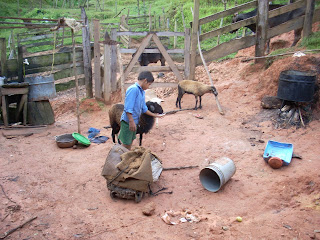
They are growing a little corn right now, mostly for feed I think, and right behind the house are a number of fruit trees, including recognizable things like coffee and oranges as well as distinctly Central American fruits like wild apples, patronas, and nances.
The house is very simple, with a pounded dirt floor and wooden walls. The main room is partitioned into two bedrooms, one with two double beds and a hammock and the other with one double bed and one single bed. Luz, the oldest, kindly gave up her bed for me and crawled in with her sisters for the night in the other room. It seems that Jose, the father, and Fermin, the baby, vie for rights to the hammock, as it is the preferred sleeping spot for both. (Many babies here sleep in small “baby hammocks” in which they can be gently rocked to sleep.) There are shelves on which to store clothes (mostly in bags and boxes to keep out critters.) The windows and doors all have tight shutters to keep out the rain and cold night air.
The kitchen is attached, with a traditional wood stove and oven, shelves for storage, a few handmade stools, a small table, and a sink made from a piece of flat metal installed at an angle and with a hole for drainage. The family pipes in water from up the next mountain, another 15 minute walk away, but it is always fresh and abundant. There is an outdoor shower and an outhouse with a rather comfortable bench seat (no splinters in my bum!)
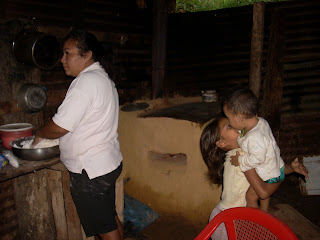
Only at night are the doors and windows all shut, so during the day there are regular visitors in the house…chickens and dogs mostly, but one burro was quite determined to join us for breakfast s well. He finally relented to go outside but only after taking a piece of cardboard that was leaning against the wall for a snack!

As the sun goes down, things do get dark, but the family has a couple of wind-up flashlights as well as a car battery they use to watch a small television. The flashlights explain a lot about why this family in particular are such good students…they can do their homework and read for pleasure after dark! Jose is quite taken with the idea of exhausting the kids by putting them to work on a bicycle driven generator…apparently I am not the first visitor to suggest such an idea. I got the kids (and I think the parents too) interested in a Spanish novel I am reading at the moment, which I read aloud while Luz (apt name at this moment) kept the flashlight wound up.
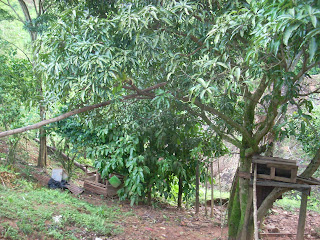
I looked out my window as night was falling and saw a most strange sight…there was a chicken in the tree! This was not something I had ever seen before. But, no, these are not special chickens that can fly or climb…they have a tree trunk leaned up into the branches which they climb to take refuge in their tree/chicken coop. The kids took me to the top of the mountain after dark so that I could see Ceiba and the sea in the distance. In addition, we got to watch a huge thunderstorm building over the ocean, which was quite spectacular to watch. And where it was so dark that you couldn’t see where the sky stopped and the tree line began, the fire flies made me think the stars were coming down to dance. During the day you can see Ceiba in the distance on one side and nothing but tree covered mountains on the other.


It may seem so simple and perhaps lacking in some ways, but I also witnessed a life rich in relationships, compassion, and self-knowledge. I cannot say that it struck me as any harder or easier than any life I’ve witnessed in more developed nations. Luz, her mom Lorena, and I passed the afternoon and most of the evening, learning to make pizza from scratch in their clay oven. The pizza recipe was new for them; the cooking apparatus was new for me. For my last day this Friday, Luz and Lorena are going to help me teach the other moms the recipe and make pizza for all of the kids for lunch! Jose asked me many questions about the US and was quite surprised when I said that I preferred life here in Honduras, where I am not constantly bombarded with the need to have more and achieve more for the sake of proving something to someone else. Luz wanted to know what kids are like in North America (she is being sponsored to study in a Canadian high school next year,) and I said that they were pretty much the same as here. The only negatives I could think of were that they are perhaps at times a little more selfish and sometimes surprisingly lacking in knowledge of what the rest of the world is like despite access to education and media.
As I said before, Luz is preparing to study in Canada after she graduates the sixth grade here in November. She is bright and kind and an all around amazing young woman. We have been reviewing some of the more difficult parts of English grammar together and also talking a bit about some of the cultural differences she’ll likely encounter. She is so excited, and rather scared (but refuses to admit it even to herself…she’s very emotionally strong!) I’ve promised to send her a pair of my flannel pajamas and my full length down coat, because her biggest fear is of the cold winter.
She asked me how long the trip was to Canada, and I said I didn’t know but that I live a little more than half way to Toronto and it takes me six hours to get home, plus whatever time I have between flights. (Her eyes got big.) How long would it take to drive, she asked. I said that with stops at night I figured it would take a little over a week, given that one has to get out of Honduras, through Guatemala and Mexico and the US. (Her eyes got even bigger.) I tried to explain that just in Texas, the state that I am from, to drive from the Mexican border to Oklahoma would be pretty much the whole day of daylight. She said she’d never imagined the whole world was that big. I laughed and hugged her and said, Luz, your world is going to get a whole lot bigger than you can probably imagine. I know mine sure did when I came to Honduras.
The Castro family has a finca, what we would call a small ranch, high in the mountains. It is a two hour walk to reach the nearest road that is passable by car. There are six children (3 boys and 3 girls, ages 15 to 1), seven cows (including the bulls and the newest calf), 3 sheep (including the newest lamb), 2 burros, 3 dogs, and the usual uncountable population of chickens.
They are growing a little corn right now, mostly for feed I think, and right behind the house are a number of fruit trees, including recognizable things like coffee and oranges as well as distinctly Central American fruits like wild apples, patronas, and nances.
The house is very simple, with a pounded dirt floor and wooden walls. The main room is partitioned into two bedrooms, one with two double beds and a hammock and the other with one double bed and one single bed. Luz, the oldest, kindly gave up her bed for me and crawled in with her sisters for the night in the other room. It seems that Jose, the father, and Fermin, the baby, vie for rights to the hammock, as it is the preferred sleeping spot for both. (Many babies here sleep in small “baby hammocks” in which they can be gently rocked to sleep.) There are shelves on which to store clothes (mostly in bags and boxes to keep out critters.) The windows and doors all have tight shutters to keep out the rain and cold night air.
The kitchen is attached, with a traditional wood stove and oven, shelves for storage, a few handmade stools, a small table, and a sink made from a piece of flat metal installed at an angle and with a hole for drainage. The family pipes in water from up the next mountain, another 15 minute walk away, but it is always fresh and abundant. There is an outdoor shower and an outhouse with a rather comfortable bench seat (no splinters in my bum!)
Only at night are the doors and windows all shut, so during the day there are regular visitors in the house…chickens and dogs mostly, but one burro was quite determined to join us for breakfast s well. He finally relented to go outside but only after taking a piece of cardboard that was leaning against the wall for a snack!
As the sun goes down, things do get dark, but the family has a couple of wind-up flashlights as well as a car battery they use to watch a small television. The flashlights explain a lot about why this family in particular are such good students…they can do their homework and read for pleasure after dark! Jose is quite taken with the idea of exhausting the kids by putting them to work on a bicycle driven generator…apparently I am not the first visitor to suggest such an idea. I got the kids (and I think the parents too) interested in a Spanish novel I am reading at the moment, which I read aloud while Luz (apt name at this moment) kept the flashlight wound up.
I looked out my window as night was falling and saw a most strange sight…there was a chicken in the tree! This was not something I had ever seen before. But, no, these are not special chickens that can fly or climb…they have a tree trunk leaned up into the branches which they climb to take refuge in their tree/chicken coop. The kids took me to the top of the mountain after dark so that I could see Ceiba and the sea in the distance. In addition, we got to watch a huge thunderstorm building over the ocean, which was quite spectacular to watch. And where it was so dark that you couldn’t see where the sky stopped and the tree line began, the fire flies made me think the stars were coming down to dance. During the day you can see Ceiba in the distance on one side and nothing but tree covered mountains on the other.
It may seem so simple and perhaps lacking in some ways, but I also witnessed a life rich in relationships, compassion, and self-knowledge. I cannot say that it struck me as any harder or easier than any life I’ve witnessed in more developed nations. Luz, her mom Lorena, and I passed the afternoon and most of the evening, learning to make pizza from scratch in their clay oven. The pizza recipe was new for them; the cooking apparatus was new for me. For my last day this Friday, Luz and Lorena are going to help me teach the other moms the recipe and make pizza for all of the kids for lunch! Jose asked me many questions about the US and was quite surprised when I said that I preferred life here in Honduras, where I am not constantly bombarded with the need to have more and achieve more for the sake of proving something to someone else. Luz wanted to know what kids are like in North America (she is being sponsored to study in a Canadian high school next year,) and I said that they were pretty much the same as here. The only negatives I could think of were that they are perhaps at times a little more selfish and sometimes surprisingly lacking in knowledge of what the rest of the world is like despite access to education and media.
As I said before, Luz is preparing to study in Canada after she graduates the sixth grade here in November. She is bright and kind and an all around amazing young woman. We have been reviewing some of the more difficult parts of English grammar together and also talking a bit about some of the cultural differences she’ll likely encounter. She is so excited, and rather scared (but refuses to admit it even to herself…she’s very emotionally strong!) I’ve promised to send her a pair of my flannel pajamas and my full length down coat, because her biggest fear is of the cold winter.
She asked me how long the trip was to Canada, and I said I didn’t know but that I live a little more than half way to Toronto and it takes me six hours to get home, plus whatever time I have between flights. (Her eyes got big.) How long would it take to drive, she asked. I said that with stops at night I figured it would take a little over a week, given that one has to get out of Honduras, through Guatemala and Mexico and the US. (Her eyes got even bigger.) I tried to explain that just in Texas, the state that I am from, to drive from the Mexican border to Oklahoma would be pretty much the whole day of daylight. She said she’d never imagined the whole world was that big. I laughed and hugged her and said, Luz, your world is going to get a whole lot bigger than you can probably imagine. I know mine sure did when I came to Honduras.
Saturday, August 1, 2009
Is this progress I’m experiencing?
It is amazing to watch a child make a big step in a developmental or educational direction. Even more amazing is when they manage to do it as a group. This past week I’ve had some real breakthroughs with my second and third graders, and I feel now that when I leave in two weeks I will have helped them achieve some very important academic improvements.
My third graders are rocking it out in the world of multiplication. Because I know that when I leave they will go back to writing and rewriting the multiplication tables under the eye of the Honduran teacher, I am focusing my efforts now on making sure they understand how multiplication works. They can now all find the answer to a simple multiplication problem that they do not have memorized and cannot see on the wall, such as 15 x 3, because they know this means there are three groups of 15.
My second graders are really coming along in subtraction with borrowing. They get so excited when it is time to borrow because they get to yell “Prestame porfavor!” (Lend it to me, please!) We still have a ways to go to achieve consistency, but major improvements are happening. As a result of some of my reading in child development, I realized that my kids didn’t understand how to count up from the number to find an answer in subtraction. For example, given 17 – 9, they are more likely to guess at the answer than to start counting on their fingers at 10 and seeing how many fingers they use to get to 17. We’ve taken a couple of days to go over this skill and there is real improvement in their accuracy now.
On Wednesday, both the kids and I got a treat (although I think mine was even bigger than theirs!) Their Spanish homework the night before was to read the recipe for making play dough from flour, water, and salt. Then they had to answer two questions for reading comprehension. Not only did my kids do the homework (breakthrough #1!), they answered the questions correctly (biggest breakthrough to date!) So we spent Wednesday morning making and playing with play dough in the classroom. What made it such a big treat for me is that they all followed directions closely and accurately, cleaned up and behaved well the entire time, and then showed off their creative minds with the play dough afterwards (and this from children who always tell me they don’t have any ideas in their heads!) The best moment was when we all put on play dough mustaches to look like deposed president Mel Zelaya…play dough gave us a chance to talk about social studies, even! And each child got a ziplock bag of homemade play dough to take home.
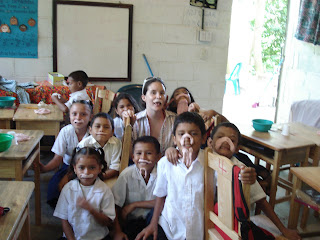
I’m still consistently stumped by some of their behaviors. My third grade girls especially are very apt to cry over a frustration or break into arguments so vehement I can’t understand what they are yelling. I’m always at a loss as to whether to intervene closely or just let them feel their way back out of the quagmire. Both methods have proven equally effective and ineffective. I know that I must make things worse when I don’t understand what they are saying, and some of the issues seem so very irrational to me that I feel they must really be stemming from something the child is unwilling or unable to communicate. Similar is the problem that when I ask a child to correct a mistake, they just shut down sometimes and refuse to work at all. I worry that there is something in the way I say it that makes them feel bad, but the more I watch the culture here, the more I see it is an issue for many adults as well.
So I have given up on the Honduran government’s lesson plans for Social Studies and Sciences and have spent the second half of the day working on self esteem and social skills instead. We’ve talked about self-esteem and imagined it as a bucket that can get holes in it that we then have to patch up. We’ve talked about the difference between a positive comment and a negative comment. We’ve taken stock of what we can do and can take pride in by coloring piggy banks full of coins on which our skills are written. We’ve created a post office “correo” for the classroom and written positive messages to each person in the room.
This coming week we’ll start a project in Spanish class about letter writing, which will culminate in each child writing a letter to a former volunteer. I’ll mail them when I get back to the States. The kids are excited for this, and I look forward to using it as a chance to practice writing CLEARLY using the posters I am making that address the kids biggest problems in letter formation.
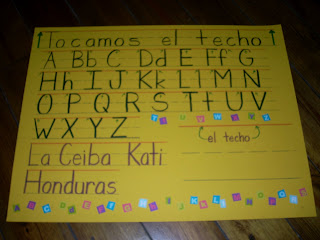
Each step is so small, it may seem like no big deal, but I can see how at this point in their education, each step for these kids is a potential leap in the future. I feel so lucky to get to help them achieve it!
My third graders are rocking it out in the world of multiplication. Because I know that when I leave they will go back to writing and rewriting the multiplication tables under the eye of the Honduran teacher, I am focusing my efforts now on making sure they understand how multiplication works. They can now all find the answer to a simple multiplication problem that they do not have memorized and cannot see on the wall, such as 15 x 3, because they know this means there are three groups of 15.
My second graders are really coming along in subtraction with borrowing. They get so excited when it is time to borrow because they get to yell “Prestame porfavor!” (Lend it to me, please!) We still have a ways to go to achieve consistency, but major improvements are happening. As a result of some of my reading in child development, I realized that my kids didn’t understand how to count up from the number to find an answer in subtraction. For example, given 17 – 9, they are more likely to guess at the answer than to start counting on their fingers at 10 and seeing how many fingers they use to get to 17. We’ve taken a couple of days to go over this skill and there is real improvement in their accuracy now.
On Wednesday, both the kids and I got a treat (although I think mine was even bigger than theirs!) Their Spanish homework the night before was to read the recipe for making play dough from flour, water, and salt. Then they had to answer two questions for reading comprehension. Not only did my kids do the homework (breakthrough #1!), they answered the questions correctly (biggest breakthrough to date!) So we spent Wednesday morning making and playing with play dough in the classroom. What made it such a big treat for me is that they all followed directions closely and accurately, cleaned up and behaved well the entire time, and then showed off their creative minds with the play dough afterwards (and this from children who always tell me they don’t have any ideas in their heads!) The best moment was when we all put on play dough mustaches to look like deposed president Mel Zelaya…play dough gave us a chance to talk about social studies, even! And each child got a ziplock bag of homemade play dough to take home.
I’m still consistently stumped by some of their behaviors. My third grade girls especially are very apt to cry over a frustration or break into arguments so vehement I can’t understand what they are yelling. I’m always at a loss as to whether to intervene closely or just let them feel their way back out of the quagmire. Both methods have proven equally effective and ineffective. I know that I must make things worse when I don’t understand what they are saying, and some of the issues seem so very irrational to me that I feel they must really be stemming from something the child is unwilling or unable to communicate. Similar is the problem that when I ask a child to correct a mistake, they just shut down sometimes and refuse to work at all. I worry that there is something in the way I say it that makes them feel bad, but the more I watch the culture here, the more I see it is an issue for many adults as well.
So I have given up on the Honduran government’s lesson plans for Social Studies and Sciences and have spent the second half of the day working on self esteem and social skills instead. We’ve talked about self-esteem and imagined it as a bucket that can get holes in it that we then have to patch up. We’ve talked about the difference between a positive comment and a negative comment. We’ve taken stock of what we can do and can take pride in by coloring piggy banks full of coins on which our skills are written. We’ve created a post office “correo” for the classroom and written positive messages to each person in the room.
This coming week we’ll start a project in Spanish class about letter writing, which will culminate in each child writing a letter to a former volunteer. I’ll mail them when I get back to the States. The kids are excited for this, and I look forward to using it as a chance to practice writing CLEARLY using the posters I am making that address the kids biggest problems in letter formation.
Each step is so small, it may seem like no big deal, but I can see how at this point in their education, each step for these kids is a potential leap in the future. I feel so lucky to get to help them achieve it!
Labels:
Honduras
Subscribe to:
Posts (Atom)


